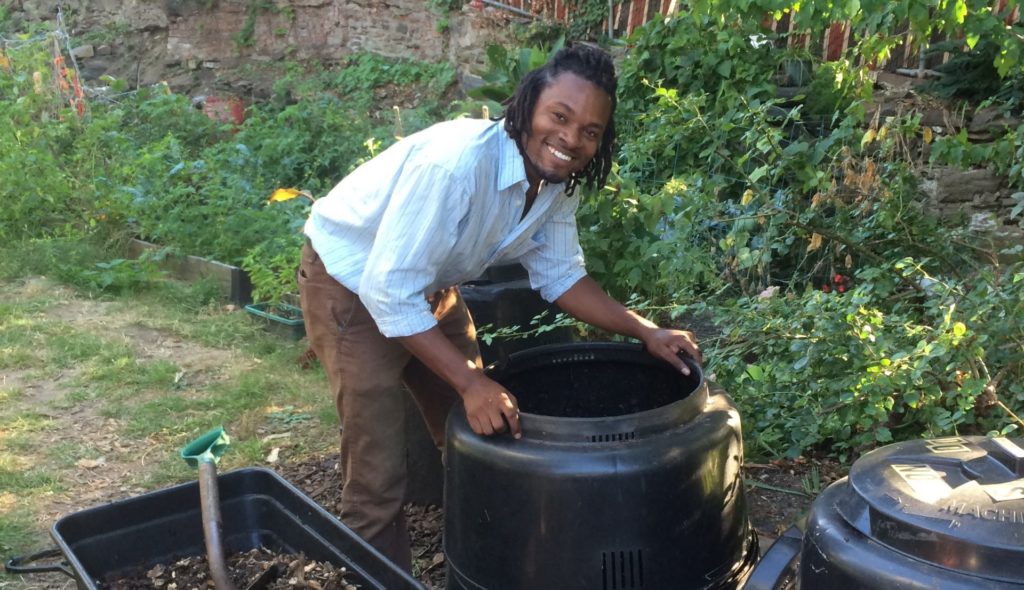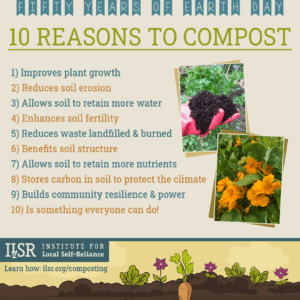
Fall is a great time to start composting, and there arguably has never been a better time to consider how to grow food and compost at home — it’s an opportunity to support healthy local soils and protect local food production and distribution. Schools, congregations, gardening groups, climate activists, and local government can promote and teach home composting. Composting is not rocket science, but learning the basics will set home composters and gardeners up for success.
ILSR Home Composting Resources
- Home Composting Basics – What, Why, and How
- Intro to Home Composting Workshop on YouTube (in full or in segments)
- Taller del Compostaje Casero en YouTube (Home Composting Workshop in Spanish on YouTube)
- Webinar – Composting at Home: An Introduction to the Basics – May 2020
- Yes! In My Backyard: A Home Composting Guide for Local Government
- How to Compost Pumpkins
- Online virtual training (contact us at Composting4Community@ilsr.org to create a customized version for your community)
- “10 Reasons to Compost” graphic. Download this infographic as a jpeg (click here).
- Smithsonian Institution’s Take Easy Action for Less Wasted Food at Home (video here) – April 2021
- Spanish-Language Home Composting Resources
 Compost is the dark, crumbly, earthy smelling material produced by the decomposition of organic materials such as food scraps and yard trimmings. When added to soil, compost sequesters carbon, improves plant growth, conserves water, reduces reliance on chemical pesticides and fertilizers, and helps prevent nutrient runoff and soil erosion. At-home or backyard composting has additional benefits. It saves local government money by avoiding the need to collect and process material.
Compost is the dark, crumbly, earthy smelling material produced by the decomposition of organic materials such as food scraps and yard trimmings. When added to soil, compost sequesters carbon, improves plant growth, conserves water, reduces reliance on chemical pesticides and fertilizers, and helps prevent nutrient runoff and soil erosion. At-home or backyard composting has additional benefits. It saves local government money by avoiding the need to collect and process material.
With all these benefits, why aren’t more people composting at home? There is a misconception that adoption is low due to poor system designs, lack of space, and odors. We disagree. Adoption is low because citizens are not incentivized to home compost and are not provided the training, guidance, equipment, and exposure to best practices to succeed. Composting is increasingly recognized as the predominant method for recycling food waste. Sadly, little attention is paid to home composting, though it is among the best opportunities to reduce food waste, especially in the near-term and especially in areas lacking facilities to compost or in communities now suspending curbside collection of food scraps due to the COVID-19 pandemic.
Another misconception about home composting is that it can only divert a small portion of residential waste. We disagree with this too. Studies indicate that 23 to 83 pounds per household per month could be diverted through home composting. Personalized training and support increases the potential. For every 10,000 households composting at home, between 1,400 and 5,000 tons per year could be diverted from curbside collection, with potential savings in avoided disposal costs alone ranging from $72,000 to $250,000.*
* Source: ILSR, Yes! In My Backyard: A Home Composting Guide for Local Government, pg. 6
Related ILSR Composting Resources
- Neighborhood Soil Rebuilders Composter Train-the-Trainer Program
- Community Composting Done Right: A Guide to Best Management Practices
- Posters and infographics:
- Hierarchy to Reduce Food Waste & Grow Community (graphic/poster listing home composting as a priority strategy)
- Composting Impacts More Than You Think (infographic and series of posters on benefits of compost to soil, climate, waste reduction, and jobs)
Links to Other Home Composting Resources
- Residential Composting During COVID-19 (US Composting Council Fact Sheet)
- Cornell Waste Management Institute’s Small Scale or Backyard Composting
- Backyard Composting – Seattle Public Utilities
- Home & Backyard Composting – North Carolina State Extension
- Vermicomposting for Households – North Carolina State Extension
- Composting – Oregon Metro
- Composting – San Diego County, Calif.
- Backyard Composting – County of Los Angeles (fact sheet has terrific details on the microbes and invertebrates in the compost pile)
- Online Home Composting Class – City of Austin
- Home Composting Program – District of Columbia
- Home Composting Made Easy (32-page illustrated guide)
- Composting in Your Backyard – USDA Natural Resources Conservation Service


